The New Studio G: Artists, Engineers, and Ideals Unite in Brooklyn
WILLIAMSBURG, BROOKLYN: Joel Hamilton has some priceless advice for any studio owner contemplating a move to a larger space.
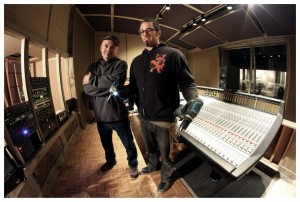
(l-r) Tony Maimone and Joel Hamiltion drill down in the new Studio G’s “A” room. (Photo credit: Shawn Maguire)
Actually, the co-proprietor of Studio G can break the action items for this complex operation into two simple steps: “First you cry,” Hamilton explains, “then pull the plug on the bottom of your bank account, and watch it drain all over town!”
Still interested in expanding? Well, obviously, there’s a lot more to it than that, and when pressed for details Hamilton – one of the planet’s most excitable talkers when the topic is recording – is more than happy to share. Alongside of Studio G co-founder Tony Maimone, Hamilton has been overseeing his facility’s ongoing transition from the one-room shop where it was born in 1993 to a 5,000 sq. ft. recording complex operating clear on the other side of Williamsburg – an often painful process, but one that’s been a long time coming.
“We’ve been pulling back the slingshot for the last 10 years!” Hamilton laughs. “A one-room facility with two engineers has a limited lifespan. You just step on each other’s toes too much of the time. The only way to grow from there is to make another studio with two rooms.”
And what a pair of rooms they are, each adding their own wrinkle to the plethora of options available to artists recording and mixing in NYC. Starting in Studio A, Hamilton goes to work on the faders of a 48 in/96 out [at mix] x 24 x 4x 2 SSL 8048 G+ (“like an SSL 4000 with SSL 9000 routing, including the 4 stereo ‘A-B-C-D’ busses”) , while visually monitoring the spacious 560 sq. ft. live room via an expansive floor-to-ceiling window that puts most other control room/live room portals to shame.
Meanwhile in Studio B, which is in its final stages of construction, the guys are flying the beloved Neve 5316 (40 x 8 x 2) from Studio G’s classic location (which continues to remain open for business for the time being). The compact Neve is connected to a slightly smaller live room that measures 525 sq ft, endowed with three big iso booths to Studio A’s two.
Locating the Ideal Studio Space in Brooklyn
Hamilton and Maimone found the new Studio G space, a former Brooklyn Industries/Triple 5 Soul warehouse that lives on a quietly humming industrial block just off of McCarren Park, after an exhaustive search of available Brooklyn real estate.
“Finding a 2500-5000 sq. ft. space that’s zoned commercial is really difficult, because it’s what everyone else also wants,” Hamilton points out. “Once we made the site selection, the actual space dictated the build. We had originally thought we would build modest rooms – just replicate the first Studio G with side-by-side studios and a hallway slit down the middle – but instead we threw away the spreadsheets of our original plan and did this: leaping into the early ‘90’s with a Neve in one room and an SSL in the other.”
They had their new studio space in hand in May 2011, when the pair sculpted their plans from the best practices their careers had exposed them to. For Hamilton, that comprises a globetrotting portfolio that includes co-producing Blakroc with the Black Keys, Pretty Lights, Matisyahu, Elvis Costello, Sparklehorse, Tom Waits, Dub Trio, Talib Kweli, Soulive, Lettuce, and countless other indie/major label artists. Maimone’s notable travels began as the bassist for Pere Ubu, then evolved into producing/engineering for the likes of Ani DiFranco, Destronauts, Peg Simone, and his own supergroup collaboration Book of Knots (of which Hamilton is also a member), to name just a few.
“Going back to Pere Ubu, Tony knew the places he loved making records,” says Hamilton. “And I knew the places that I thought worked the best. So this place is an amalgamation of a pretty large pool of experiences between Tony and me, rather than being designed by an architect who had his own ideas about how the space should be.”
In the large Studio A control room, warm woods and carefully culled fabrics surround the SSL 8048 G+, a pristine console which previously enjoyed a privileged existence at NFL Films in Mount Laurel, NJ. Averse to summing boxes (“its kind of the MP3 of consoles”), both Maimone and Hamilton were thrilled to finally locate an affordable, commercial grade mid-size board from the relatively rare SSL 8000 G+ series. Mix in the fact that this 8048 G+ had been rigorously maintained on a broadcast TV schedule, and pouncing on the console was a no-brainer for the Studio G team.
What may be less clear is why Hamilton – hailed far and wide as an indie recordist’s recordist – would opt for an SSL, and all of its platinum associations. So allow him to explain his decision.
“Having a dogma attached to a piece of gear is bullshit,” Hamiltion states. “I own a Neve! I don’t see them (SSL and Neve) as mutually exclusive. That’s a flawed premise. This SSL answers a lot of questions when you mix, just like the Neve answers a lot of questions when you have Marshall amps in the live room and the band is ready to rock.
“I find the SSL to be incredibly flexible, very natural, and we have a lot of color that we can add from the outboard gear in the racks. Michael Brauer really felt that his SSL 9000 was the first time that he could have this channel sound like a Distressor, this one sound like a Tri-Tronics, and then have the next channel sound like a different compressor. This board sounds like nothing until you put a thing on it. It’s up to you. There’s nothing automatic-sounding for every channel. So if you have a vision of how you want things to sound, this is a great tool. It’s worth mentioning that we still keep a ton of Neve channels and cool vintage pre’s in the rack behind the SSL.
“Feeling like a Neve console, or tape, helps to make things turn out great is valid, but in this case, with the SSL, you’re steering it – we have the luxury of patching in a channel that people may find colorless or not. We could do an Erykah Badu record one day, AC/DC the next, and a purist jazz recording right after that. That flexibility, to me, is part of the new breed of thinking that this generation of engineer has, rather than staying tied to a way of thinking about a particular piece of equipment.”
When it comes to those sound-shaping tools, Hamilton and Maimone made the seemingly counter-intuitive decision to begin migrating the outboard gear to the new G that they tended to use the least at the old location. “(The classic) Studio G will keep rocking until the B room is completely done,” says Hamilton. “We started here with the equipment that we didn’t want to pay to put in a storage space – it’s literally the least of what we have, and it’s all the weird stuff. This DaviSound two-channel optical compressor is a great example: It’s like a freakish LA-3A that I love, with meters that just flop around and mean nothing, but the line amps add a great color right when you patch it up.”
Live from Studio A
All the better to focus on getting the sounds right on input from the studio A live room, a sizable 25’ x 28’ main live space — complete with a 1908 Bosendorfer grand piano and two iso booths — that provides a transporting experience upon entry.
“I wanted a big, very live space with lots of cubic volume and a linoleum drum room, like in Avatar’s Studio A and C, which I love,” Hamilton says. “The main space is really balanced, for the same reason that theaters and churches work so well acoustically without any trademark diffusors. The angle between the top of the iso booths and the ceiling makes that whole area a trap, and that grabs a lot of the low mids. Tracking strings has been amazing in this room.”
One of the best expressions of the Studio G artist-centric philosophy lies neither in A’s live room or the control room, however, but in that aforementioned 8 ft. x 8 ft. span of glass in between them. “There’s something about floor-to-ceiling glass that doesn’t feel disconnected – it feels like something you could walk through, instead of dividing us,” observes Hamilton. “There’s a connection between the two rooms, energy-wise, but with acoustic isolation. I’m a fan of the people I record, and with this design I can be more supportive in that role.
“You can actually be there for the people on the other side of the glass in a very literal way,” he continues. “Your presence is clear – you’re not checking email when they’re tracking. Instead, this is part of giving the artist the sense that what they’re doing matters. It’s the foundation of what we do. How can it not be? My experience of being on the other side of the glass, and Tony’s too, guides everything. The whole thing is to serve the musician.”
Being Studio B
Meanwhile, the facility’s Studio B is fast approaching completion, and should provide the perfect counterpoint to the SSL-based 21st Century Temple of Sound. “Studio A is more like a studio, while B feels more like a repurposed French farm house living room that just happens to be on floated floors,” he says. “The control room is a little smaller than in A, but the Neve is smaller than the SSL, so it fits the room in the same way. B also has the three iso spaces, plus an airlock, so you can have up to four things happening at the same time with complete isolation.”
Complementing the Studio G options is the presence of bassist/engineer Jeff Hill’s (Brazilian Girls, Rufus Wainwright) private production suite, a space that feels amazingly lived-in for the short time that it’s been in operation. “Jeff’s room has its own personality,” says Hamilton. “You can tell someone is in there.”
The last near-future addition on the agenda is a reverb chamber that will be constructed in the building’s basement. “For the chamber we’re making a weird, flopped-on-its-side, industrial shower room,” Hamiltion enthuses. “It’ll be a slab with a six-foot ceiling, plaster on the side, speaker, and microphones. We already have a conduit going down there, so we’re psyched, because we got addicted to having a real acoustic chamber in the mix at our original location.”
“It’s a huge part of the workflow! Because with a lot of things that people give me these days, the vocal is recorded in a hotel room, while the guitar might be recorded in a bedroom. The 2% that’s missing, you can put back in the mix with a chamber and pull it all back together, instead of sounding like it was made all over the world — a real acoustic chamber can put ‘eye contact’ back in the performances.”
A Community-Based Approach to Recording
In its expansive new guise, Studio G emphasizes the communal approach that drives its founders to not just make outstandingly expressive music with their clients, but to bring as many interested people as possible in on the process – whether it’s at their studio or any other on the planet.
“It’s about an inclusionist aesthetic – because when everyone collects together and works as a team, things get better for everybody on that team,” Hamilton says. “A family of studios that share a common aesthetic all get business when we all start talking about each other. Enthusiasm – the love of recording and the process of making records – is infectious.”
On the other hand, Mssrs. Hamilton and Maimone most assuredly are realizing a personal expression – and maybe even an obsession – with this 5,000 sq. ft. statement in the artistic heart of Brooklyn.
“I need to make stuff within these walls,” Joel Hamilton says. “I keep heading toward a vision, which is why this place is dripping with intent. It’s what Studio G is all about, and I would hope that’s how it reads when you walk in: Whoever built this place really gives a shit about making records.”
— David Weiss
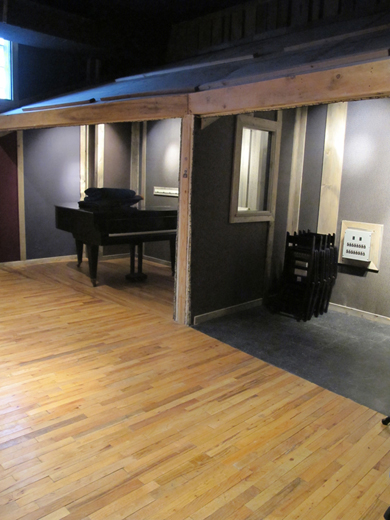
The iso booths in Studio A’s live room (prior to the addition of sliding glass doors), complete with 1908 Bosendorfer. (Photo: Janice Brown)
Please note: When you buy products through links on this page, we may earn an affiliate commission.







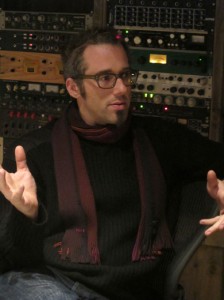
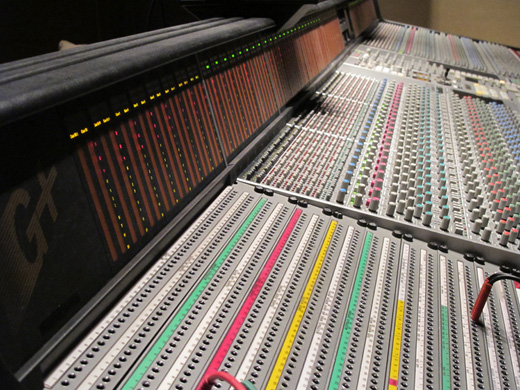
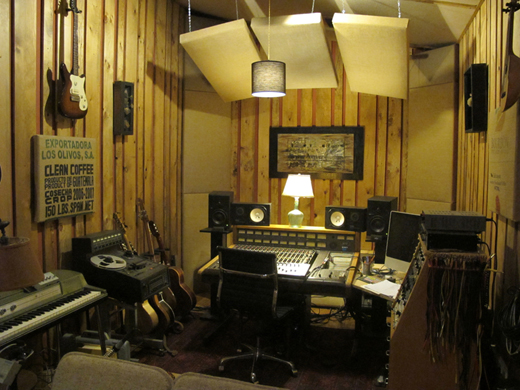
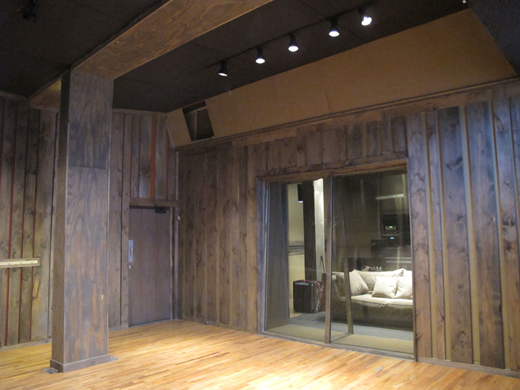
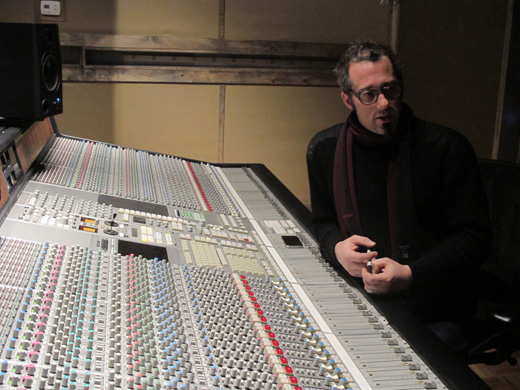
Mike
April 9, 2012 at 2:58 pm (13 years ago)congrats guys.
Moko
March 10, 2015 at 11:26 am (10 years ago)I have been in this room and it is magical! Joel is a great host @ AES Party and what a great vibe!